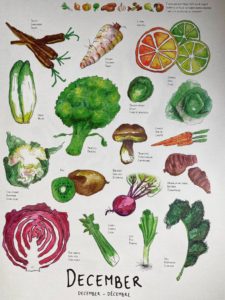Moving from sunny South Africa to Europe I became much more aware of the seasons and the distinct differences between them. It is as if the same landscape assumes four different persona’s or is dressed for four different occasions: Spring, Summer. Autumn and Winter.
Isn’t it therefore logical for us to adapt our diets, habits and lifestyles according to the changes in the outside world? I am learning to live in alignment with the cycles in nature and enjoy the bounty and experience each season has to offer. In which season do you feel your healthiest and happiest? For me, it is definitely not winter. I struggle with the cold and especially the dark European winters.
Here are my winter wellness tips to help you through the cold dark months:
- Consume warm food and drinks – Cooked warm foods and drinks are easier to digest and require less energy to metabolise. We can therefore use our energy more efficiently for other processes like keeping warm and fuelling our immune system.
- Wear a hat in cold weather – we lose much of our body heat through our heads so cover-up when outside!
- Keep your neck warm with a scarf – our necks are another vulnerable point of heat loss where exposure to a chilly wind can cause a respiratory illness.
- Use humidifiers in your home – indoor heating dries out the air and our nasal passages making them more prone to irritation and infection.
- Avoid taking naps during the day – our winter rhythm has shorter days and longer nights. Keep active and productive during daylight and slow down and hibernate when it gets dark. Daytime napping could interfere with your metabolism potentially slowing it down contributing to unwanted weight gain.
- Exercise more – I know this feels counter-intuitive but just do it! Keep active and keep moving to prevent extra winter kilo’s from piling on.
- Wear bright colours – Where black and navy seem to be everybody’s winter wardrobe basics, choose a bright shade of your favourite colour and wear it!

Each season has a unique tempo and a different rhythm. After almost five years I have learnt to recognise them and adjust myself, my diet, my activities, and my lifestyle to flow with each season. Some adjustments are easy and can occur unconsciously, others need a more mindful approach and take effort and discipline.
Discovering novel vegetables
I became acquainted with some new winter vegetables that were foreign to me. Honestly, I find it a challenge to try new unfamiliar foods. Most people who know me probably think that I have a healthy appetite. It is true that I have a healthy appetite now, but that was not always the case and it is something I work on constantly. Especially on winter days, I succumb to stress, cravings and comfort eating. But because of my health expertise, my commitment to healthy eating is not negotiable at least 80% of the time. Such is the 80/20 rule sufficient to keep my personal health balance and stay sane.
I also have a restless spirit which craves variety and enjoys experimenting which is a contradiction which thankfully often wins over my risk averseness. I think every international has experienced both the excitement and overwhelm of ‘the new’ and may relate to how a new place with its new culture and foods can be both stimulating and threaten to overwhelm.
It really helps to be surrounded by internationals with foodie knowledge and experience. They have shared their favourite dishes and other recipes from their culture with me. It has been such a stimulating experience of full spectrum culture and cuisine that has added variety and taste to my existing repertoire. My advice is if you come across some weird vegetable ask a friendly local how they cook it and try it at least once!
Eating with the seasons
I believe strongly that the health of our planet mirrors the health of our bodies. Eating with the seasons means eating produce at its natural harvest time. These times can vary from location to location, but essentially seasonal produce is what you can grow in your own garden or greenhouse without artificial light or heating.

What produce is in season in western Europe this winter?
Fruit: Citrus & Kiwi fruit
Cruciferous vegetables: Broccoli, cauliflower, kale, cabbage, Brussels’ sprouts
Root vegetables: carrots, parsnips, beetroot, Jerusalem artichoke, turnips
Other: Endive, celery, leeks, mushroom
Benefits of eating seasonal produce
- Taste In-season produce tastes better than produce that has been picked before it is ripe, stored and transported across the globe.
- Nutrient content Nutrients in seasonal fruit mirror what our bodies require for optimal health given the seasonal conditions. For example, in autumn wild mushrooms provide vitamin D to help with the fading light and in winter, citrus fruits provide vitamin C to support against winter colds.
- Cost Seasonal produce is cheaper because of a high supply vs lower demand ratio.
I think that living in alignment with the seasonal conditions and eating what the earth naturally produces at any given period (without too much artificial intervention) is beneficial to both our personal health and wellness and our planet. Go on… try it!
Written by Nicole Cullinan – Homoeopath, Functional Medicine consultant and creator of Wellness Place International
















